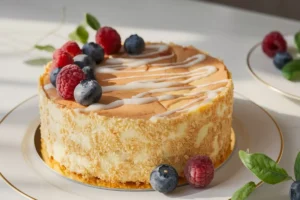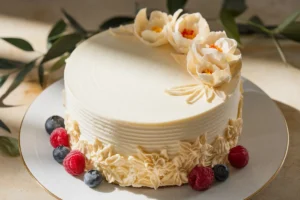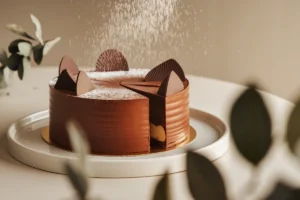Desserts like cake and gâteau often get confused, but they are not the same. Gâteaux, which come from French patisserie, bring a more sophisticated touch with their elegant designs, richer flavors, and detailed preparation. Understanding the unique qualities of a gâteau can change how you appreciate this special dessert.
Defining Cake and Gâteau
What is a Cake?
Cakes are popular desserts worldwide, enjoyed in many variations across cultures. A cake is a baked sweet made from flour, sugar, eggs, and butter or oil. Cakes range from simple sponges to complex, multi-layered creations filled and topped with frosting.
Cakes come in many types, such as light and airy sponge cakes or rich and dense pound cakes. Though the ingredients and methods can vary, the basic elements remain the same: a baked mixture often topped with icing or frosting. Cakes are versatile and can suit many occasions, as explained by Pediaa.
What is a Gâteau?
The word “gâteau” means cake in French, but it stands for much more than that. Gâteaux are elaborate desserts that focus on layers, complex flavors, and artistic presentation. They often include mousses, fresh fruits, creams, and high-quality ingredients, creating a luxurious dessert. According to Recipes.net, gâteaux are designed with attention to detail and aesthetics, making them a highlight in French patisserie.
Unlike standard cakes, gâteaux focus on refined textures and flavors. They are often the center of attention at special events, especially in France, where they represent a high level of dessert artistry.
Key Differences Between Cake and Gâteau
Ingredients and Layers
- Cakes use basic ingredients like flour, sugar, eggs, and butter, often paired with simple frostings or icings.
- Gâteaux go beyond with almond flour, ganache, and fresh seasonal fruits. They feature complex layers with mousses, creams, and custards.
Gâteaux are known for their layered structures, where each part enhances the dessert’s overall taste. While cakes may stick to one type of frosting, gâteaux combine multiple textures, making each bite unique.
Presentation and Aesthetics
Presentation sets gâteaux apart from cakes. Though cakes can be decorated beautifully, gâteaux feature intricate designs and artistic touches that stand out.
- Cakes: Typically decorated with basic icing, buttercream, or fondant, and simple toppings like fruit or sprinkles.
- Gâteaux: Showcase layers of mousse, fresh fruits, and detailed garnishes, reflecting a higher level of skill.
Gâteaux are not just desserts—they are crafted to be the star of the dessert table with their elegant looks.
Texture and Consistency
Cakes vary from light and airy to dense and moist, depending on how they are made. Gâteaux are known for their lighter, more delicate textures, often created with whipped creams and mousses.
- Cakes: Textures range widely, from the fluffiness of sponge cake to the richness of pound cake.
- Gâteaux: Known for light, refined textures that often melt in the mouth, thanks to their mousse or cream layers.
This lighter feel makes gâteaux seem more refined and less heavy than traditional cakes.
Flavor Profiles
Cakes often feature classic flavors like vanilla, chocolate, or red velvet, sometimes with added fruits or nuts. Gâteaux, on the other hand, offer more sophisticated combinations, including liqueurs, exotic spices, and high-quality ingredients.
- Cakes: Straightforward, familiar flavors.
- Gâteaux: More refined, with flavors like hazelnut praline, dark chocolate ganache, or passion fruit mousse.
Gâteaux focus on quality ingredients and unique blends, making them an exciting choice for dessert lovers.
Types of Cakes vs. Types of Gâteaux

Common Cake Varieties
- Sponge Cake: Light and airy, made by beating eggs, often used for layered cakes.
- Pound Cake: Dense and buttery, traditionally made with equal parts flour, sugar, butter, and eggs.
- Chiffon Cake: A mix of sponge and butter cake, known for being moist and airy.
- Angel Food Cake: Very light and fluffy, made with egg whites and no fat, often paired with berries.
Popular Gâteaux Examples
- Gâteau St. Honoré: Combines puff pastry, choux pastry, caramel, and rich cream; it’s a stunning centerpiece.
- Black Forest Gâteau: Features layers of chocolate sponge, cherries, and whipped cream, topped with chocolate shavings.
- Fraisier: A delicate strawberry gâteau with sponge layers, fresh strawberries, and light cream, often topped with marzipan.
These gâteaux balance flavors with artistic presentations, making them stand out from regular cakes.
Cultural and Culinary Significance
The Role of Cakes in Different Cultures
Cakes are celebrated in many cultures, appearing in various forms. From England’s Victoria sponge to Italy’s tiramisu, cakes are linked to special occasions. They symbolize joy, indulgence, and festivity, reflecting cultural traditions.
Cakes are commonly seen at birthdays, weddings, and holidays, often highlighting regional flavors and customs.
Gâteaux in French Cuisine
In France, gâteaux are the gold standard of dessert making. They are not just sweet treats but also expressions of culinary skill and artistic talent. French patisseries display their gâteaux proudly, showcasing the detailed work that goes into each piece.
Gâteaux are typically reserved for special occasions, such as weddings, anniversaries, or upscale gatherings. Their presence in French cuisine highlights the importance of quality, detail, and the artistry of dessert-making.
Preparation Techniques
Baking Techniques for Cakes
Cakes are usually prepared with simple baking methods:
- Creaming Method: Mixing butter and sugar to create a fluffy mixture, often used for butter cakes.
- Whisking Method: Beating eggs and sugar until airy before folding in flour, commonly used for sponge cakes.
- Folding and Blending: Mixing gently to retain air, which is essential for light textures.
Gâteau Preparation
Gâteaux require more precision and skill, often involving several steps:
- Tempering Chocolate: Creates a shiny finish and crisp texture in decorations.
- Whipping Creams and Mousses: Necessary for the light, airy textures found in many gâteaux.
- Layering and Assembling: Careful construction of layers, including sponge, cream, mousse, and fruit.
These advanced techniques make gâteaux a unique blend of taste, texture, and visual appeal.
Common Misconceptions About Cakes and Gâteaux

Gâteaux Are Just Fancy Cakes
One common misconception is that gâteaux are merely fancier versions of cakes. While gâteaux do share some basic elements with cakes, they stand apart due to their complexity, richer ingredients, and a higher level of artistry in both taste and presentation. Gâteaux often feature multiple layers, various textures, and refined flavors, making them much more intricate than the average cake.
Gâteaux Are Too Expensive or Difficult to Make
Many people think that making a gâteau requires special skills or expensive ingredients. However, while gâteaux do demand more precision and creativity, they are not impossible to make at home. With practice, patience, and a willingness to learn, anyone can create a gâteau that rivals those found in French patisseries.
All Gâteaux Are Cakes, But Not All Cakes Can Be Gâteaux
There is also a misunderstanding that any cake can be labeled a gâteau. Although all gâteaux are technically cakes, not all cakes meet the standards to be called a gâteau. Gâteaux focus on luxury, using high-quality ingredients, advanced baking techniques, and elegant presentations that elevate them above typical cakes.
Gâteaux Are Only for Special Occasions
Some believe that gâteaux are reserved strictly for celebrations or special events. While gâteaux do often appear at significant gatherings, they can also be enjoyed at any time. Their elegant appearance and sophisticated flavors make them a delightful choice for anyone who appreciates a well-crafted dessert, even without a special occasion.
Gâteaux Are Always Healthier Than Cakes
There is a misconception that because gâteaux often use fresh fruits and light creams, they are always a healthier option compared to regular cakes. However, gâteaux can be just as rich or even more calorie-dense due to the creams, chocolates, and layers of mousse used. The focus of a gâteau is more on taste, texture, and presentation rather than being a healthier dessert choice.
Understanding these misconceptions helps clarify what truly makes a gâteau distinct, allowing you to appreciate this dessert for its unique qualities and craftsmanship.
Misunderstanding Between Cake and Gâteau
Many assume that gâteaux are just fancier cakes. Although gâteaux share some elements with cakes, they stand out due to their complexity, richer ingredients, and artistic presentation. Gâteaux often include multiple layers, diverse textures, and more refined flavors.
Another misconception is that gâteaux are always difficult or expensive. While they do require more skill, anyone can learn the techniques with practice and dedication.
FAQs
- What is the main difference between cake and gâteau?
Gâteaux are more complex in flavor and look, using high-quality ingredients and detailed techniques. - Are all gâteaux cakes, but not all cakes are gâteaux?
Yes, while all gâteaux are cakes, not all cakes meet the standards of a gâteau due to its focus on luxury and artistry. - Why are gâteaux considered more luxurious than cakes?
They use premium ingredients like dark chocolate, fresh cream, and seasonal fruits, often featuring multiple layers and textures. - Can a cake be turned into a gâteau? How?
Yes, by adding elements like mousses, creams, and artistic touches while refining flavors and presentation. - What are the health implications of consuming gâteaux compared to regular cakes?
Gâteaux can be richer and more calorie-dense due to the creams, butter, and high-fat ingredients used.

Conclusion
Cakes and gâteaux may seem similar, but they differ significantly in ingredients, preparation, and presentation. A gâteau is more than a cake—it is a form of edible art that showcases the elegance and creativity of French patisserie. Whether enjoying a simple slice of cake or savoring a luxurious gâteau, each dessert reflects the dedication and artistry of its creator.

